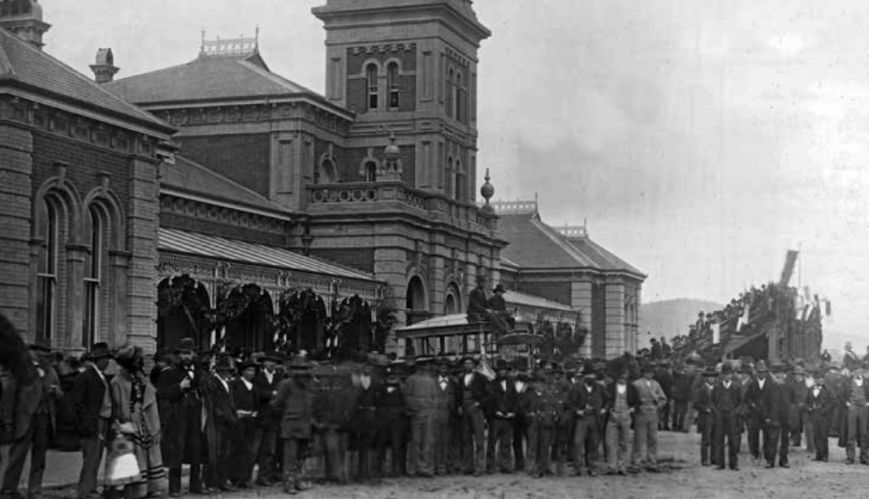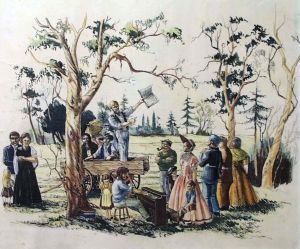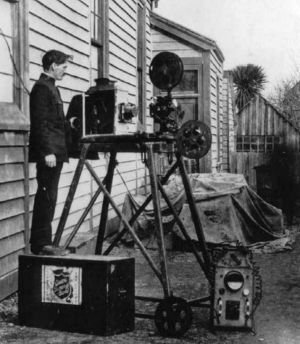Army assault on Australia all in God's timing

Army assault on Australia all in God's timing
The official opening of Albury railway station, completing the rail link between Sydney and Melbourne, on 14 June 1883. (Photograph, courtesy of the State Records Office NSW). The Salvation Army quickly utilised the link as a means of spreading the Gospel.
When two English immigrants, John Gore and Edward Saunders, held the first unofficial Salvation Army meeting on 5 September 1880 in the Botanic Park in Adelaide, they were probably unaware of how God was working to shape the destiny of The Salvation Army in the emerging nation of Australia.
 A painting depicting the occasion when John Gore and Edward Saunders led the first official Salvation Army meeting in Australia from the back of a greengrocer’s cart in Adelaide’s Botanic Park on 5 September 1880.
A painting depicting the occasion when John Gore and Edward Saunders led the first official Salvation Army meeting in Australia from the back of a greengrocer’s cart in Adelaide’s Botanic Park on 5 September 1880.
During the latter part of the 19th century, as The Salvation Army made its appearance in Australia, there were great social, economic and infrastructure changes and development.
There was little doubt that Australia was ready for change. There was a move to throw off colonial shackles and move toward freedom and independence. Events like the uprising at the Eureka Stockade in Ballarat, Victoria, in 1854 pointed to a rising tide of nationalism, disenchantment with British rule and a desire for democracy.
While it could well have been a time of revolution and bloodshed, the noted historian Dr Rob Nicol was to comment that Australia “didn’t need a Civil War, or a War of Independence or any form of violence, it was all developed by the will of the people, by peaceful means.”
In hindsight, we can trace the hand of God moving to establish and build his Salvation Army at an opportune moment in the nation’s development. There are striking parallels between the spread and development of the gospel in the first century and the spread and development of The Salvation Army in Australia. God does not work impervious of human history; he participates within it to fulfil his purposes.
Perfect timing
The rapid development of the Christian Church in the first century was not just some accidental occurrence. God chose to establish his church at a precise moment in the world’s history.
Paul alludes to the significance of God’s timing when he writes: “But when the fullness of the time had come, God sent forth His Son ...” (Galatians 4:4).
During the first century, the spread of the Gospel and the development of the Christian Church were greatly facilitated by three factors:
• The Pax Romana (Roman peace) that enabled a secure environment;
• The system of Roman roads facilitating faster and more direct travel;
• The Greek language, giving the then-known world a common language of communication.
In the late 19th century, similar factors facilitated the commencement and development of The Salvation Army in Australia:
• The Pax Britannica (British peace) enabled a secure environment for The Salvation Army, a British-based mission to establish itself. In 1880, when The Salvation Army made its first appearance in Australia, the British Empire under Queen Victoria was at its peak, and British rule facilitated a secure environment.
• New methods of travel, such as the steamship and railways, were being developed to allow the rapid movement of people.
• Communication reached new heights, with English being the common language of trade throughout much of the world. The telegraph became an accepted means of communication, and a new invention known as the telephone became operational.
 An early Gaumont projector used by The Salvation Army Limelight Department (Image courtesy of the Alexander Turnbull Library.)
An early Gaumont projector used by The Salvation Army Limelight Department (Image courtesy of the Alexander Turnbull Library.)
Photography and the advent of moving pictures enabled those in Australia to catch visual glimpses of what was happening around the world. The invention of the movie camera, or cinematograph as it was known, in the 1890s was particularly important to the fledgling Salvation Army as it began to use film to present the Gospel message.
Moving with the times
When The Salvation Army burst onto the scene, the stage was set for the Army to significantly impact this part of the world. Salvation Army leadership in those early years was bold, innovative and forward-thinking, creating an organisation that was highly mobile and appealing, especially to those of the working class.
The Army quickly utilised much of the new technology available to proclaim and spread its message of God’s love and salvation for all.
As Australia moved towards Federation and nationhood, The Salvation Army, through its evangelical and social initiatives, was to weave itself into the fabric of the community and secure a unique place in the nation’s psyche.
This article is adapted from In The Fullness of Time. The complete text can be read in Hallelujah! magazine, titled: The story of The Salvation Army in the Western South Pacific, Volume 1, Issue 1. Available from Salvationist Supplies, Sydney.